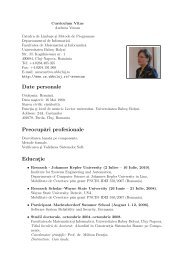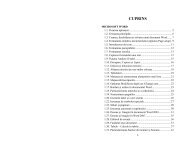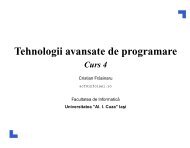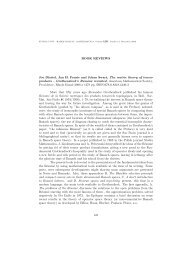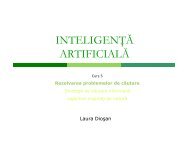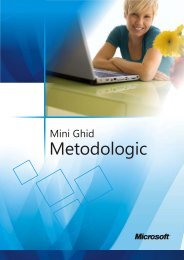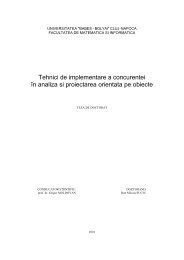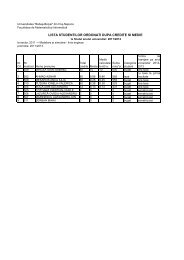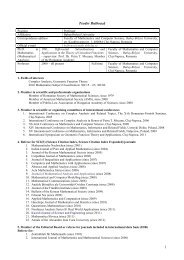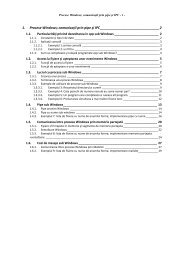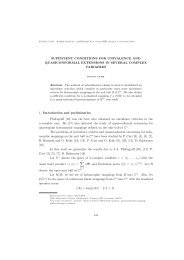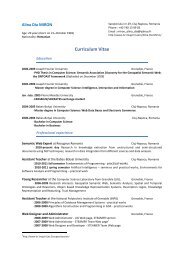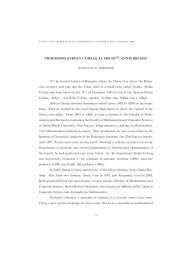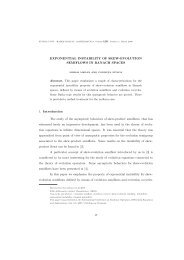CONTENTS
CONTENTS
CONTENTS
You also want an ePaper? Increase the reach of your titles
YUMPU automatically turns print PDFs into web optimized ePapers that Google loves.
A FORMAL CONCEPT ANALYSIS APPROACH TO ONTOLOGY SEARCH 221<br />
can help us find the search elements in the search space by using synonyms, meronyms<br />
and other word relations that can alone be the subject of an entire paper.<br />
The concepts found in the previous step are, each one of them, the start point of<br />
an ”extracted lattice”. This lattice is to be constructed in a similar manner with the<br />
initial lattice but taking into account a concept radius. This can be seen as sort of<br />
a threshold for a concept set extracted from the search space. Starting from a found<br />
concept, the agent constructs a lattice by including all the concepts related to the<br />
found concept while staying withing the boundaries given by the concept radius. The<br />
concept radius can be any function defining types of relations between concepts and<br />
a simple example of such a function is the ontology relations set itself.<br />
After the lattice has been extracted from the search space around the starting<br />
point, the agent starts integrating it in the main lattice. This can be done by means<br />
similar to FCA-Mapping[2] but since we started the search with the concepts from<br />
the main lattice, we already have the information regarding to what concept to link<br />
the extracted lattice to. Each starting point can be linked to a subset of concepts<br />
from the initial domain when they are found in the search space, and this process of<br />
integration will be done for each one of them.<br />
After obtaining the generated lattice, by combining the initial lattice with the<br />
extracted ones, we can measure the degree of similarity between the initial domain<br />
and the current ontology by analyzing the generated lattice. There are multiple<br />
metrics we can use here, including the number of lattice concepts, the structure of<br />
the lattice, how well connected are the concepts and how many clusters we have and<br />
so on.<br />
3. Related Work<br />
Formal Concept Analysis has been mixed in the computer science field for a while<br />
now and not without good reasons according to its strong supporters for its benefits<br />
[11], but not until fairly recently researchers in the ontology field became interested<br />
in its potential [13, 2]. At the moment there are applications both theoretical [10, 9]<br />
and practical 2 that are using the power of FCA and this shows, without doubt, that<br />
FCA has some leverage in the knowledge related fields. However, we have the string<br />
belief that FCA has much more potential in this area as an ontology tool for tasks<br />
like similarity[3], mapping, validation and enhancement.<br />
References<br />
[1] Timothy J. Everts, Sung Sik Park, and Byeong Ho Kang. Using formal concept analysis with<br />
an incremental knowledge acquisition system for web document management.<br />
[2] Liya Fan and Tianyuan Xiao. FCA-Mapping: A method for ontology mapping. In Proceedings<br />
of the European Semantic Web Conference, 2007.<br />
[3] Anna Formica. Concept similarity in formal concept analysis: An information content approach.<br />
In Knowledge Based Systems, 2007.<br />
[4] Suk-Hyung Hwang. A triadic approach of hierarchical classes analysis on folksonomy mining.<br />
In IJCSNS International Journal of Computer Science and Network Security, VOL.7 No.8,<br />
August 2007.<br />
2 http://sourceforge.net/projects/conexp



